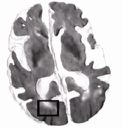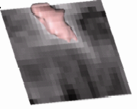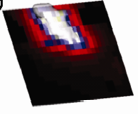
Associate Professor and Director of Biomedical Imaging

White matter hyperintensities (WMHs) are the bright spots on T2-weighted brain MRI scans. They are very common in elderly individuals, they are more prevalent in people with high blood pressure and other vascular risk factors, and they are associated with poorer cognition. But it is not entirely clear what they represent biologically, how they come about, or why they would inhibit the ability to think. Since 2005 I have pursued methodological research on automated quantification of WMHs, and neuroscience research on associations between WMHs, vascular risk factors, and cognition, to try to answer these questions. Below are brief descriptions of two projects within this area.
------------------------------------------------------------------------------------------------------------------
My graduate student, Chris Schwarz, developed techniques for fully-automated detection of WMHs based on various types of MRI images, including T1-weighted, PD/T2-weighted, and FLAIR sequences. Example inputs to his algorithm are shown below to the left, and the right-hand image gives the ground-truth WMH locations.

Chris used a prominent graph-based approach called Markov Random Fields to detect WMHs. He showed that various operating parameters have a big effect on the ability to detect WMHs. He further showed that one can make WMH detection dramatically more efficient by taking the simple, drastic step of removing edges from the graph.
Chris used this approach to detect WMHs in over 4000 MRI scans from the Alzheimer’s Disease Neuroimaging Initiative (ADNI).
Publications:
C. G. Schwarz, E. Fletcher, C. DeCarli, and O. T. Carmichael. Fully-Automated White Matter Hyperintensity Detection With Anatomical Prior Knowledge and Without FLAIR. Proceedings of Information Processing in Medical Imaging (IPMI), 2009 (Acceptance Rate: 39%). DOI
Christopher G. Schwarz, Evan Fletcher, Baljeet Singh, Amy Liu, Noel Smith, Charles DeCarli, Owen T. Carmichael. Most Edges in Markov Random Fields for White Matter Hyperintensity Segmentation are Worthless. Proceedings of the International Conference of the IEEE Engineering in Medicine and Biology Society (EMBC 2012). DOI
Christopher G. Schwarz, Alex Tsui, Evan Fletcher, Baljeet Singh, Charles DeCarli, Owen T. Carmichael. Impact of Markov Random Field Optimizer on MRI-based Tissue Segmentation in the Aging Brain. Proceedings of the International Conference of the IEEE Engineering in Medicine and Biology Society (EMBC’11). DOI
------------------------------------------------------------------------------------------------------------------
I have been working with Pauline Maillard, a postdoctoral fellow in Charlie DeCarli’s lab, to describe how WMHs grow and change over time. Pauline has discovered that WMHs are surrounded by brain tissue that are injured to a lesser degree than the WMHs are. Below is an image of a brain MRI slice with a WMH (left, black box); a rendering of the WMH as a pink blob (middle); and a depiction of the subtly-injured white matter surrounding the WMH in red (right).



The fact that there is a “penumbra” surrounding the WMH makes us think that these brain abnormalities evolve gradually and continuously over time, with the WMH being just the “tip of the iceburg” of injured brain tissue.
Pauline went on to show that most of the change over time in WMHs consists of existing ones growing bigger—not new ones popping up here and there. And, existing WMHs growing over time was associated with greater mental problems over time, while the emergence of new WMHs had less of an effect on thinking. This further supports the idea that most of what we see in WMHs consists of a continuous, slowly-evolving process.
Publications:
Pauline Maillard, Owen Carmichael, Evan Fletcher, Bruce R. Reed, Dan Mungas, and Charles S. DeCarli.Coevolution of White Matter Hyperintensities and Cognition in the Elderly. Neurology July 31, 2012 vol. 79 no. 5 442-448. DOI
Pauline Maillard, Evan Fletcher, Danielle Harvey, Owen T. Carmichael, Bruce Reed, Dan Mungas, Charles DeCarli. White Matter Hyperintensity Penumbra.Stroke, Jul;42(7):1917-22. 2011. DOI